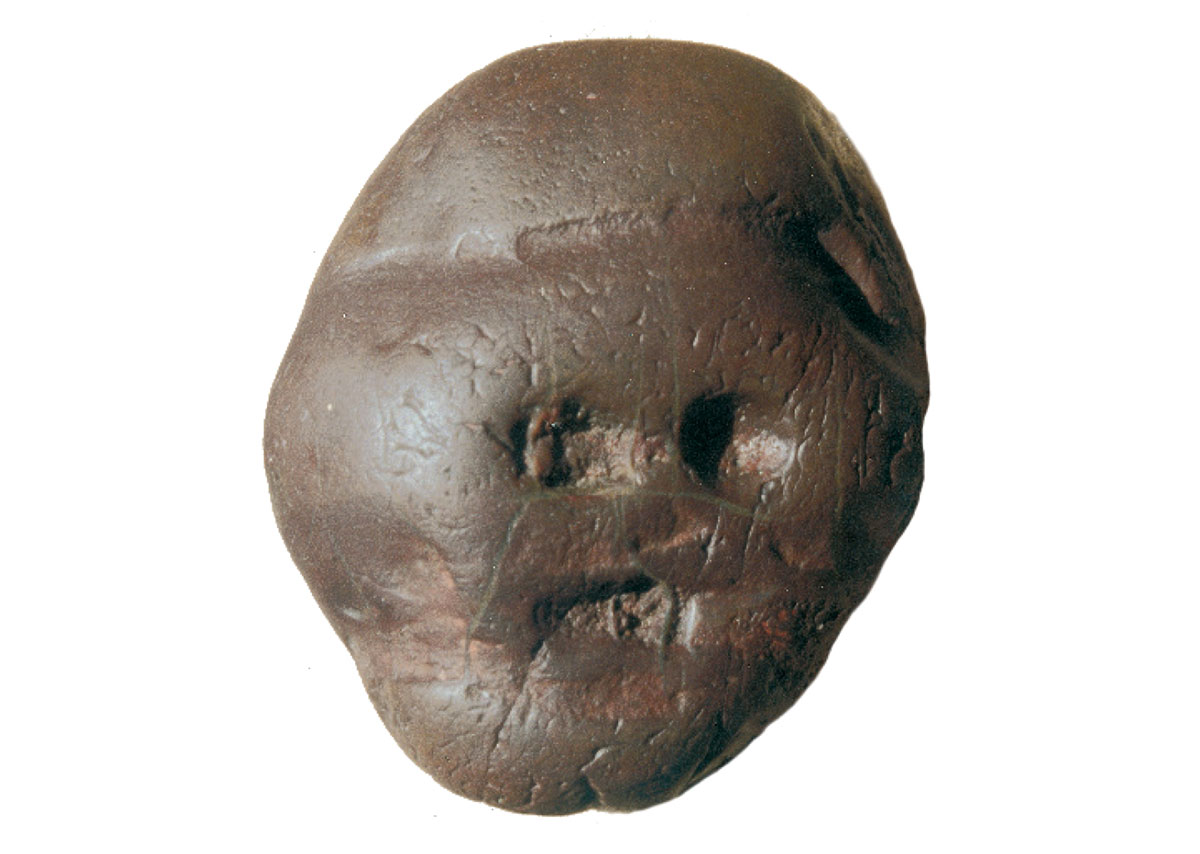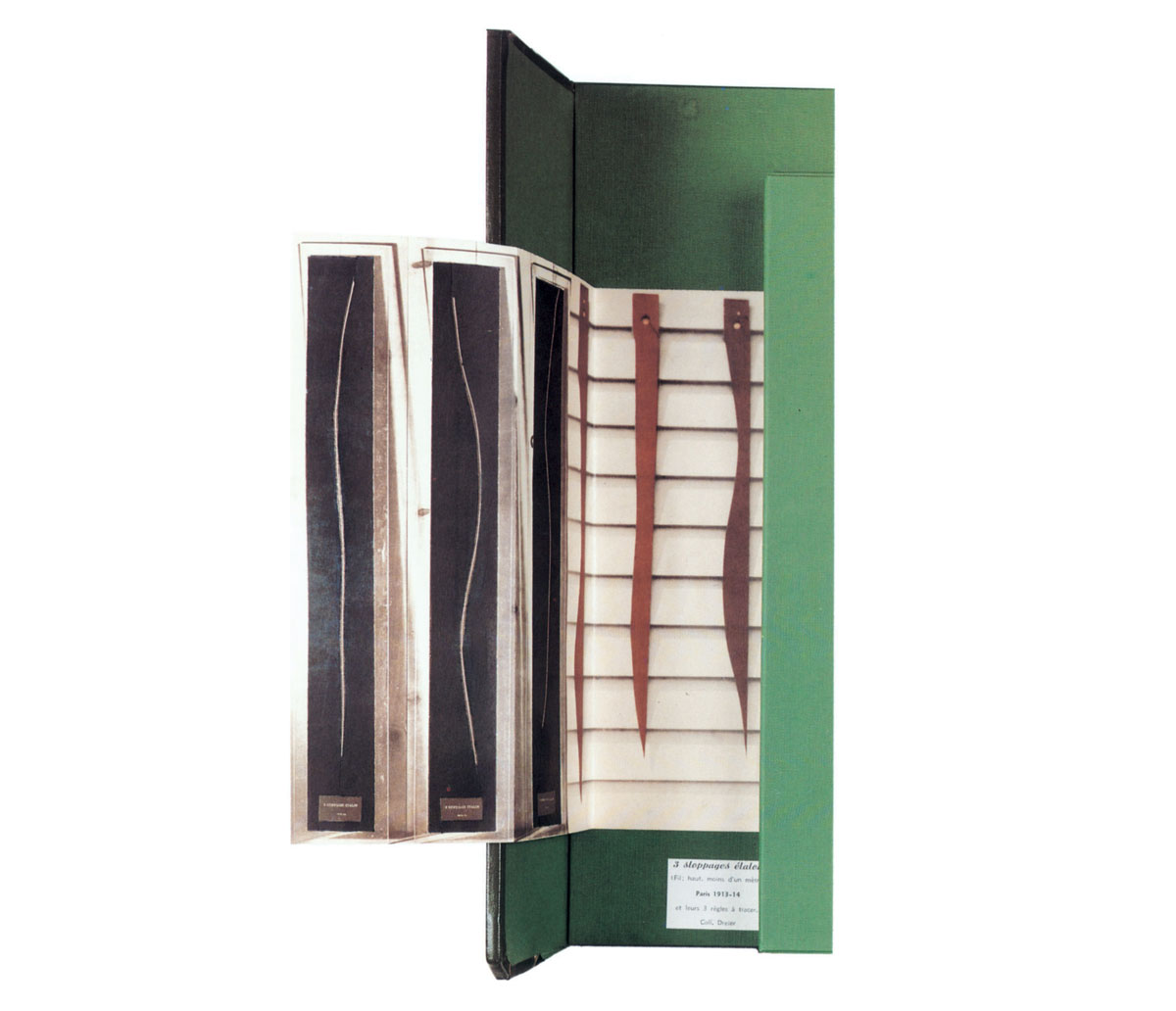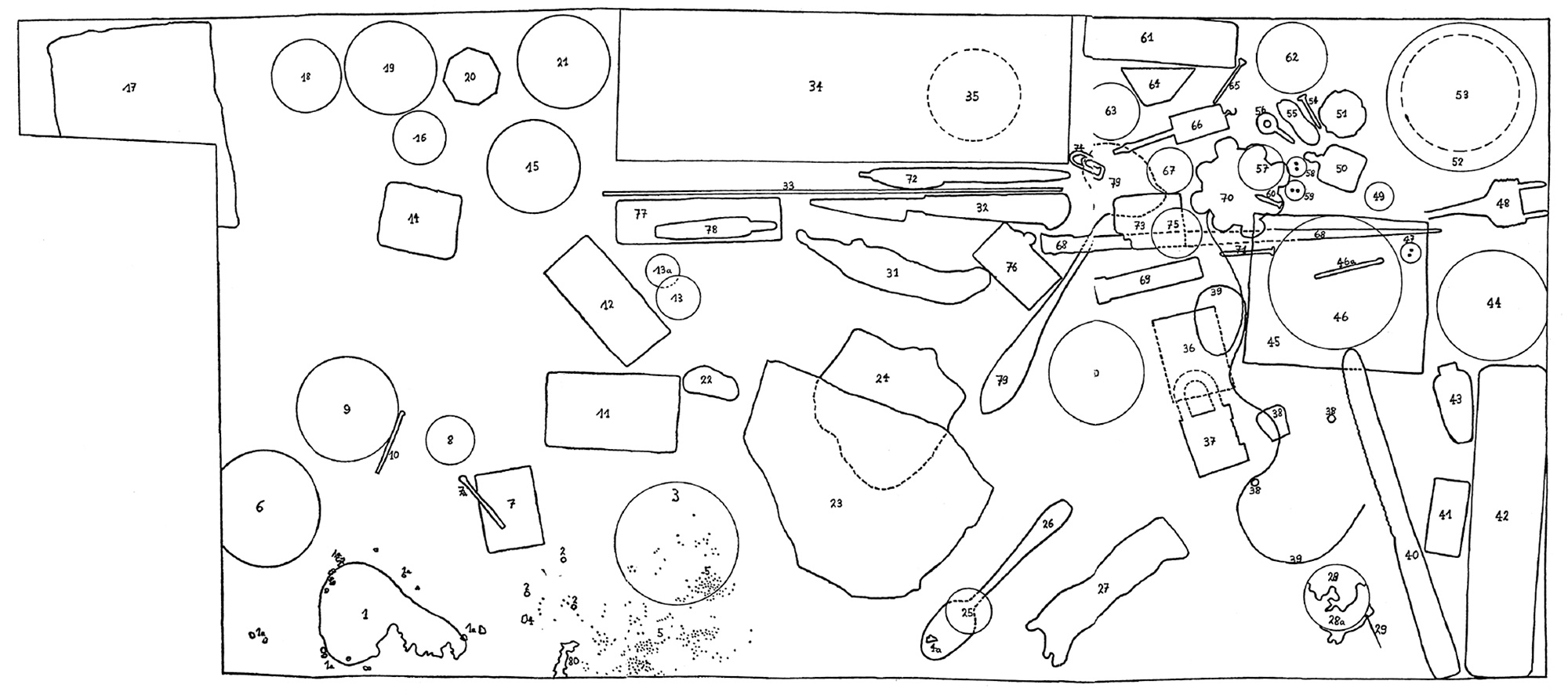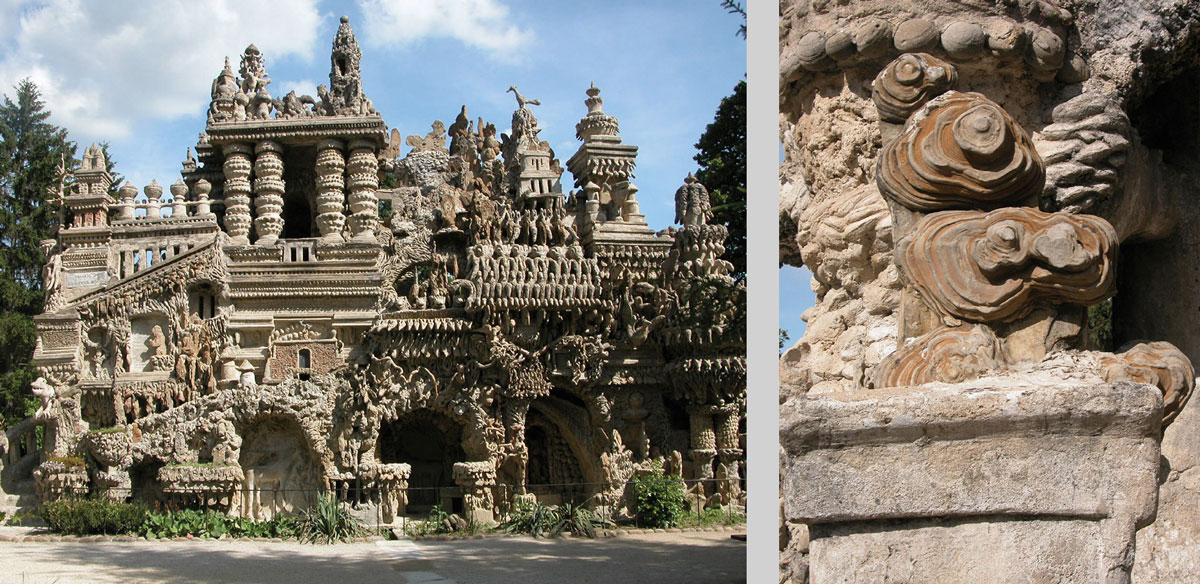Stumbling Over/Upon Art
Chance as a creative ally
Dario Gamboni
“Chance in art” can mean many different things, so numerous and so varied that one may be tempted to dismiss the term as a misnomer or a lexical straw man, like so many adherents to the notion of divine or natural causality have done in the past: “Chance seems to be only a term, by which we express our ignorance of the cause of any thing.”[1] But there may be a plane on which at least some of these meanings and forms meet and which can illuminate them—this essay will attempt to locate it.
One classical interpretation of “chance in art” is that of the “image made by chance.”[2] The phenomenon is documented across times and cultures and can be understood as a particularly explicit manifestation of the active, cognitive (or “projective”) nature of visual perception. In fact, the earliest known “image” associated with humans—or rather pre-humans—, the pebble found at Makapansgat in South Africa, is supposed to have been selected, transported, and preserved some three million years ago because it happened to look like a face.[3] Rather than the first work of art, it can claim to be the first Readymade, as one commentator facetiously remarked.[4] Depending on the current views of the origin and working of the universe, such “images” have been attributed to the gods, God, or some other supernatural beings; to Nature acting as an artist or to her blind mechanical laws; or to man’s own eye and mind, the human imagination, or the “unconscious.”

The last group of interpretations, which could be labeled “endogenic,” first gained prominence in Late Antiquity and the Renaissance, and has dominated the Western understanding of this question from the late eighteenth century to the present.[5] Despite its apparently monistic character, it does retain a crucial element of the earlier “exogenic” interpretations: for the accidental image to be perceived as an image, a “sender” must be at least implicitly postulated by the receiver.[6] If this sender is situated in the receiver, it becomes an Other within the subject. This explains the connection between chance images and Freud’s notion of “the uncanny” (das Unheimliche) and the fascination they have exerted upon the Surrealists.
Because of this sense of something or someone communicating, the agent, when perceiving an image made by chance, experiences himself or herself to be a “patient,” to be a “passive recipient.” In the early twentieth century, Marcel Duchamp extended this experience beyond the iconic image and turned it into an experiment. The demonstration of this move was made with Trois stoppages étalon [Three Standard Stoppages], which used a mock-scientific procedure to subvert the quantitative and iterative basis of the mechanistic and deterministic worldview: the unit of length is destroyed if the shapes adopted by a one-meter-long thread falling three times from a height of one meter are regarded as relevant, as the artist made clear by deriving from them three templates used in the production of other works including the Large Glass. Duchamp defined this operation as “canned chance” and explained later: “This experiment was made in 1913 to imprison and preserve forms obtained through chance, through my chance.”[7]

Alfred Gell’s relational notion of artistic agency, based on the agent/patient dynamics and extended beyond the artist’s figure, can help us understand the rationale of this “experiment.” Duchamp’s work involved letting the thread “distort itself as it pleases and create a new figure of the unit of length.”[8] Letting the thread act “as it pleased” obviously meant abandoning it to another “will,” that of universal gravity. The following note, also preserved in the “Green Box,” thus mocks the exaggerated claims to control made by politics—following those of science—by imagining a “Ministry of coincidences. / Department / (or better): / Regime of coincidence / Ministry of gravity.”[9] A similar pattern of oscillation between agent and patient position is manifest in the description given by Duchamp of the genesis of his Readymade Trébuchet [Trap]: “... a real coat hanger that I wanted sometime to put on the wall and hang my things on but I never did come to that—so it was on the floor and I would kick it every minute, every time I went out—I got crazy about it and I said the Hell with it, if it wants to stay there and bore me, I’ll nail it down... and then the association with the Readymade came and it was that.”[10] The artist’s agency is defeated by the object’s stubborn resistance and active obstruction, until he reverses the situation and reclaims for himself this very opposition, makes it definitive, and lifts it from a physical to an ontological plane by recognizing the nailed coat hanger as a Readymade.
One cannot miss the analogy between this scene and slapstick comedies, in which humans are regularly confronted with objects that escape control and exert their own agency with a vengeance. In Buster Keaton’s The Electric House (1922), for example, the ultra-modern, all-mechanized house turns into a nightmarish trap that persecutes its users and especially its designer. Slapstick films were at the height of their popularity at the time when Duchamp was playing and fighting with bicycle wheels, one-meter-long threads, bottle dryers, snow shovels, combs, typewriter covers, urinals, coat racks, and hat racks. These films were largely based on improvisation and accident—in the first 1921 shooting of The Electric House, Keaton had fallen victim to his reversible escalator—and they exploited the analogy and interchangeability between the human and the mechanical that fascinated Duchamp and in which Henri Bergson had recognized a crucial trigger for laughter.[11]
Among twentieth-century artistic recourses to chance, it has been suggested that a distinction be made between “hand-made” chance—close to traditions of spontaneity and automatism that one encounters, for example, in Surrealism and Abstract Expressionism—and a mathematical kind of chance often inspired by probability theory that uses protocols and is more frequent in geometric abstraction and some forms of performances.[12] These are poles rather than categories, however, and they share the crucial feature of distributing artistic agency. The theory of economic agency provides a useful model here by describing small systems or organizations in which the agent, acting by proxy in the name of a “principal,” “is to choose among a number of alternative possibilities.” Agency is therefore delegated, and this delegation implies an essential element of uncertainty: “The outcome is affected but not completely determined by the agent’s action.”[13] The artist as principal can, in turn, involve other artists, assistants, the public, and all sorts of objects, instruments, and materials—and of course natural laws such as gravity—as agents in this sense.
In fact, all twentieth- and twenty-first-century art can be described in these terms, which could also help analyze the still little-publicized procedures devised by those who, like Lawrence Weiner with his statements or Sol Lewitt with his wall drawings, produce quasi-allographic forms of art by delegating to others a part or the entirety of the material realization of their works.[14] And the same model could also serve to describe the organization implied in the making of works before the idea of undivided labor became a defining criterion of art and to put this idea into historical perspective. Seen in this broader context, “chance in art” or rather the recourse to chance may only apply to cases and situations in which the delegation of artistic agency takes particularly explicit and sometimes conscious forms. Their relation to science need not only be one of opposition but also of emulation and even of similarity, especially if one considers science in the making rather than science as it is reconstructed ex post facto in the name of method or laid out programmatically to raise funds.[15] André Corboz has thus provocatively but correctly suggested finding a model of realistic and efficient art historical methodology in the legend of the three Princes of Serendip and their reliance on the “happy accident.”[16] Serendipity also defines artistic activity in the famous quote attributed to Picasso, “I do not seek, I find,” which dismisses in a radical way the tendency to suppose a telos to each action and to make it a key to interpretation.
Having taught a few seminars on “the use of chance in art,” I have realized that the heuristic potential of this question tends to be limited by the habits of binary or dualistic thinking, i.e., the implicit expectation to find only chance or, instead, no chance. In fact, as the idea of delegated and distributed agency suggests, what happens in the making of a work of art is always a mixture of control and lack of it, a pattern of abandoning and reclaiming agency. But it is true that, like “handmade” and “mathematical” chance, total control and total absence of control can represent poles, even though they must be qualified in relation to the relevance, for the final aesthetic judgment, of what is left by the artist to other forces to determine.
Despite its integration in a broader—and maybe universal—typology of the management of artistic agency, the “recourse to chance” may thus be distinguished by the search for, or the welcoming of, a foreign intervention that promises or imposes an unknown and unexpected result. This is the case whether a metaphysically transcendent quality is attributed to this foreign character or not, and it accounts for the centrality of the use of chance in the movements dedicated to the pursuit of innovation and in twentieth- and twenty-first-century art at large. We have encountered or supposed this element of surprise and accident in the Makapansgat pebble and in Duchamp’s experiments with objects. Duchamp compared the making of a Readymade to a rendezvous, and the programmatic use made by the Surrealists of the definition of beauty borrowed from Lautréamont—“the chance encounter of a sewing machine and an umbrella on a dissecting table”—aligns it with Antoine Cournot’s definition of chance as the result of the meeting of two or more independent series of causes.[17]
A particularly apt image of this accidental encounter is the stumbling block, which Duchamp literally appropriated with Trébuchet, the title of which means “a trap for little birds” or “a little pair of scales,” but also evokes the verb trébucher, to stumble. In the 1960s, the generation of artists who discovered in Duchamp a benevolent and provocative grandfather also elaborated upon this invention, and Daniel Spoerri started turning tabletops with glued objects into “trap pictures” (tableaux-pièges). Its graphic—and arguably superior—version, the small book Topographie anecdotée du hasard [Anecdoted Topography of Chance] preserves the horizontal outline of all the objects that happened to stand or lie on the artist’s table on 17 October 1961 at 3:47 p.m. and describes their identity and how they had come to be there. Spoerri “traps” the objects but, to the extent that they determine his picture, he is trapped by them, in advance of his reader—and one could add that he runs the risk of being trapped by their recognition of an ever less accidental “signature style.”[18] Closer to our time, it is telling that Jeff Wall, who stages photographs like long-feature films and pushes control until it meets some irreducible element of chance, should have found in the most implausible Stumbling Block an image that exacerbates the tension between the instant of shooting and the permanence of the work. One could speak of a “stumbling picture,” a concept used by Joseph Beuys to describe (as Stolperbilder) the works of Sigmar Polke, an artist more obviously indebted to chance.[19]

The stumbling block also acts as a challenge to rise—after falling—to the accidental circumstances. According to le facteur (Joseph-Ferdinand) Cheval, the primus motus behind his “Ideal Palace” was a “bizarrely shaped stone” on which he stumbled and which, corroborated by other findings, led him to think: “Since Nature wants to do the sculpting, I will do the masonry and the architecture.” Nature was clearly not the only challenger of the country postman who devoted thirty-three years of his life to a “monument” summarizing the cultural history of mankind and proclaiming “what a peasant can do,” but its continued provocation is visible everywhere in the form of accidental (or aided) sculptures. The initial stumbling block is said to sit on top of a pedestal on the terrace of the West side: it is indeed a remarkable object, one that evokes not so much iconic associations as the stones that Chinese scholars used to treat like sculptures and in which Octavio Paz has seen an antecedent to the Readymade.[20]

- William Paley, Natural Theology: or, Evidences of the Existence and Attributes of the Deity, Collected from the Appearances of Nature (s.l., 1802), quoted from J. A. Simpson and E. S. C. Weiner, eds., The Oxford English Dictionary, 2nd edition (Oxford, 1989), III, 10. See Dario Gamboni, “‘Fabrication of Accidents’: Factura and Chance in Nineteenth-Century Art,” Res: Journal of Anthropology and Aesthetics, no. 36 (Fall 1999), pp. 205–225.
- See Horst W. Janson, “The ‘Image Made by Chance’ in Renaissance Thought,” De Artibus Opuscula XL. Essays in Honor of Erwin Panofsky (New York: New York University Press, 1961), I, pp. 254–266; H. W. Janson, “Chance Images,” in Philip P. Wiener, ed., Dictionary of the History of Ideas: Studies of Selected Pivotal Ideas (New York: Scribner’s, 1973), I, pp. 340–353; Jean-Claude Lebensztejn, L’art de la tache. Introduction à la Nouvelle méthode d’Alexander Cozens (Paris: Limon, 1990).
- Robert Bednarik, “The ‘Australopicethine’ Cobble from Makapansgat, South Africa,” South African Archaeological Bulletin, no. 53 (1998), pp. 4–8.
- Wolfgang Krischke, “Anfang der Kunst. Kieselig,” Frankfurter Allgemeine Zeitung, 80 (7 April 1999), N5.
- See Dario Gamboni, Potential Images: Ambiguity and Indeterminacy in Modern Art (London: Reaktion Books, 2002).
- See Erhard Schüttpelz, “Höhere Wesen befahlen,” in Gerhardt von Graevenitz, Stefan Rieger and Felix Thürlemann, eds., Die Unvermeidlichkeit der Bilder (Tübingen: Narr, 2001), pp. 187–203.
- Marcel Duchamp, Duchamp du signe. Ecrits, Michel Sanouillet and Elmer Peterson, eds., (Paris: Flammarion, 1991), p. 50 [1912–1915]; Marcel Duchamp, “Apropos of Myself” [1964], quoted in Anne d’Harnoncourt and Kynaston McShine, eds., Marcel Duchamp (Munich: Prestel, 1989), p. 273.
- Duchamp, Duchamp du signe, p. 50. My emphasis.
- Ibid., p. 51.
- Interview with Sidney Janis, 1953, quoted in d’Harnoncourt and McShine, eds., Marcel Duchamp, op. cit., p. 283.
- Petr Kral, Le burlesque, ou la morale de la tarte à la crème (Paris: Stock, 1984), p. 56; Henri Bergson, Le rire. Essai sur la signification du comique (Paris: Alcan, 1900).
- Claude Faure, “Hasard et arts plastiques,” in Emile Noël, ed., Le hasard aujourd’hu (Paris: Seuil, 1991), pp. 67–79.
- Kenneth J. Arrow, “Agency and the Market,” in Kenneth J. Arrow and Michael Intriligator, eds., Handbook of Mathematical Economics (Amsterdam : Elsevier, 1986), III, p. 1183, quoted in Etienne Balibar and Sandra Laugier, “Agency,”in Barbara Cassin, ed., Vocabulaire européen des philosophies. Dictionnaire des intraduisibles (Paris: Robert/Seuil, 2004), pp. 26–32.
- For a recent collection of such “delegations of agency,” see Hans Ulrich Obrist, ed., Do It (New York/Frankfurt: e-flux/Revolver, 2005); on the notion of allographic art and what distinguishes Weiner’s or Lewitt’s works from it, see Nelson Goodman, Languages of Art: An Approach to a Theory of Symbols (Indianapolis/Cambridge: Hackett, 1976), pp. 113–123 (especially p. 119).
- See Bruno Latour, Laboratory Life: The Construction of Scientific Facts [1979], (Princeton: Princeton University Press, 1986); Hans-Jörg Rheinberger, “Historische Beispiele experimenteller Kreativität in den Wissenschaften,” in Walter Berka et al., eds., Woher kommt das Neue? Kreativität in Wissenschaft und Kunst (Wien/Köln/Weimar: Böhlau, 2003), pp. 29–49.
- André Corboz, “La recherche: trois apologues” [1997], in André Corboz, Le territoire comme palimpseste et autres essais (Besançon: L’Imprimeur, 2001), pp. 21–30, p. 259.
- See Antoine Cournot, Exposition de la théorie des chances et des probabilités (Paris: Hachette, 1843); André Breton, Manifeste du surréalisme [1924], in André Breton, Manifestes du surréalisme (Paris: Gallimard, 1969), p. 51; André Breton, L’amour fou (Paris: Gallimard, 1937), p. 31.
- For an English translation, see Daniel Spoerri, An anecdoted topography of chance (re-anecdoted version), done with the help of his very dear friend, Robert Filliou, and translated from the French, and further anecdoted at random by their very dear friend, Emmett Williams, with one hundred reflective illustrations by Topor (New York: Something Else Press, 1966; London: Atlas Press, 1995). The preceding thoughts on Daniel Spoerri are gratefully indebted to Fabienne Lavennex.
- Der Tagesspiegel (15 May 1966), quoted in Sigmar Polke. Die drei Lügen der Malerei, exhib. cat.: Nationalgalerie im Hamburger Bahnhof, Berlin (Berlin: SMPK,1997), unpaginated [43].
- Octavio Paz, Apariencia desnuda. La obra de Marcel Duchamp (Mexico D.F., Era, 1978), pp. 35–36.
Dario Gamboni is professor of art history at the University of Geneva. He is the author of numerous publications on the art of the nineteenth and twentieth centuries, including The Destruction of Art: Iconoclasm and Vandalism since the French Revolution (Yale University Press, 1997) and Potential Images: Ambiguity and Indeterminacy in Modern Art (Reaktion Books, 2002).
Spotted an error? Email us at corrections at cabinetmagazine dot org.
If you’ve enjoyed the free articles that we offer on our site, please consider subscribing to our nonprofit magazine. You get twelve online issues and unlimited access to all our archives.